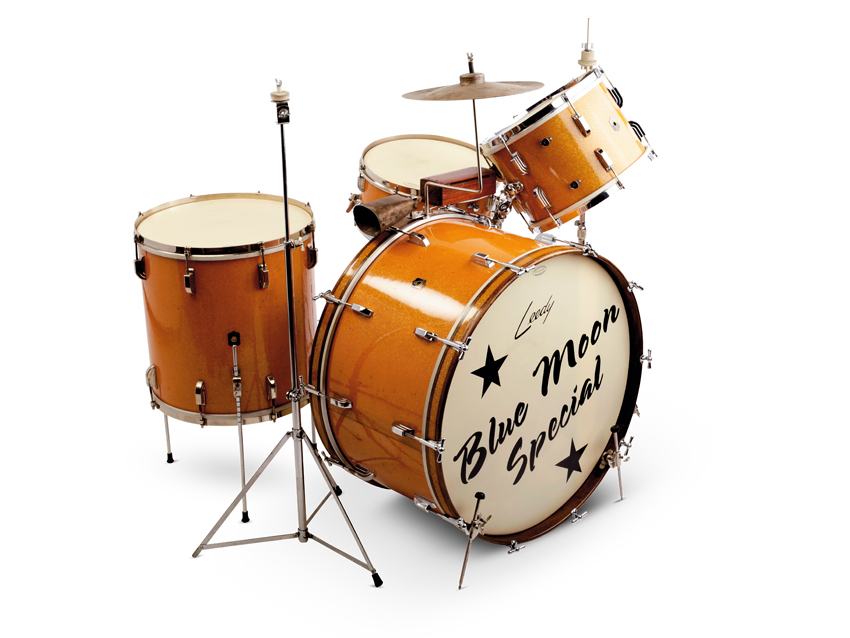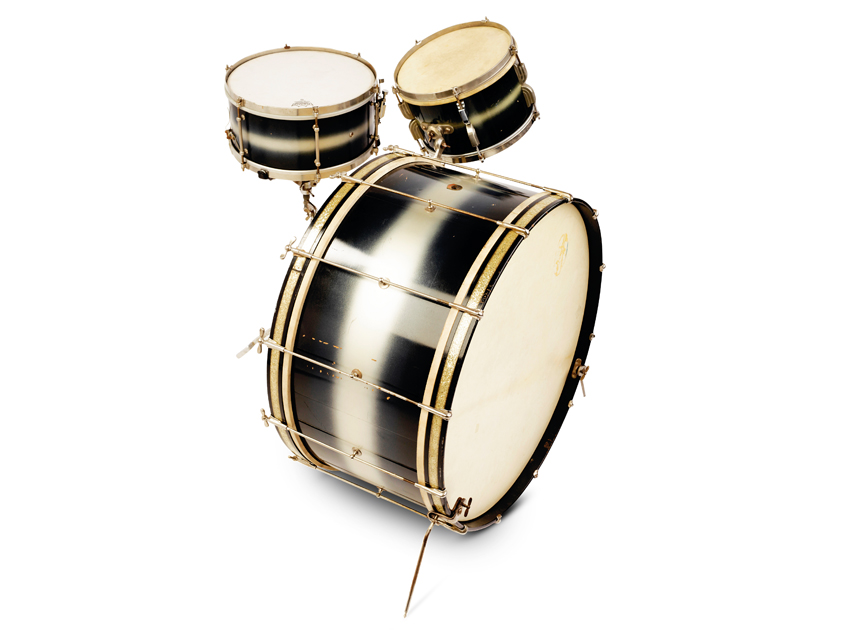Vintage drum gear: Leedy kits
A pair of beautiful '40s kit from the innovative US drum maker

Leedy Broadway Nite Club kit
Each month Rhythm Magazine tracks-down and checks-out vintage gear in order to marvel at a bit of drum-making history.
It’s back to the USA this time for a stunning Leedy kit in Sparkling Gold, which belongs to Amsterdam drummer and dealer Winnie Mensink.
“We used to have this band called Blue Moon Special playing early rock’n’roll,” explains Winnie. “It was all retro-style, so I needed a late 1940s set with a 26" bass drum. I bought it off Mark Cooper’s Vintage Drums. It is a 1949 Leedy Broadway ‘Nite Club’. The sizes are 14"x61⁄2", 26"x14", 13"x9" and 16"x16".
“In the 1940s the Nite Club was Leedy’s top outfit. In the 1945 catalogue it has a 28" bass drum, plus an extra 14"x12" tom. By 1949 the standard figuration was a 24" bass drum with 13", 16" and matching snare, but an optional 26" could be ordered at a little extra cost. So in 1949 this set was priced at $357, plus $36.50 for the chrome hardware.”

Leedy Broadway Nite Club kit
Suffering ill health, Ulysses Grant Leedy relinquished his company to the Conn corporation in 1929.
Manufacturing was moved from Indianapolis to Elkhart, Indiana. Conn also took over Ludwig & Ludwig whose drums were henceforth made in the same factory. Leedy had been at the forefront of drum evolution and design, due at first to Mr Leedy himself and thereafter via the ingenuity of George Way.
One of several Leedy/Way innovations was the non-binding ‘floating head’ principle, which means the shells are slightly undersized in diameter.

Leedy Broadway Nite Club kit
The shells are three-ply mahogany-poplar-mahogany, with maple reinforcing rings, painted white inside and date stamped 4909 – September, 1949.
All the drums have streamlined Beaver Tail lugs, first seen in 1939. Toms still have single-flanged hoops while the snare sports double-flanged hoops. The snare is a Broadway Standard with extension strainer. This elegant design has a roller bar outrigger which allows extended snares to be fitted and holds the strings away from the edge of the head.
Making Winnie’s kit even more desirable is the authentic hardware including a Leedy XL bass drum pedal and Leedy XL hi-hat pedal.
“This is one of the nicest sets I’ve ever owned,” says Winnie, “and I still have it, although the band doesn’t exist anymore. I currently have the set on display in my shop, but every time I look at it I want to start a new band so I could use it again. Maybe some day...”

Leedy kit
Staying with Leedy, this vintage kit is a few years older than the Leedy Broadway. It was brought along to the 2012 NDF by Tony Hillebrandt, who has since sold it on.
Although the drums sit well together as a kit, they come from slightly different stages of the drumset’s early-20th century evolution: each of the three drums has different lugs and hoops, but the fact that they are finished in the same Tri-Tone blue-white-blue lacquer suggests they have always been a kit.
Certainly the various drums were available contemporaneously in Leedy’s extensive catalogues of the mid- to late-’40s. But this kit combines a huge bass drum, typical of the military/orchestral monsters used in the 1920s/’30s, with a basic-model snare and a more forward-looking double-headed tom with die-cast lugs.

Leedy kit
The 28"x14" bass drum is a Spartan model with full complement of 12 single-tension rods. These have claw hooks and tension ‘T’ handles on the playing side and slip through single central locating studs on the shell, screwing into the receiver claws that hook over the front hoop.
The Spartan was Leedy’s budget bass drum model, although Leedy also made Spartan bass drums that had double tension, front and back. Single tension models were built in sizes right up to 34"x16" and this particular example has Sparkling Silver inlaid hoops - which was a five-dollar extra - alongside the Tri-Tone finish. The shell is thin three-ply mahogany with solid maple reinforcing rings.

Leedy kit
As its name implies, the 14"x61⁄2" Utility snare drum was a basic student workhorse snare from Leedy’s extensive snare drum range. It has the bare minimum of six double-ended tube lugs and flat plate steel hoops, the top one of which is stamped ‘Leedy Utility Model’.
The drum originally came fitted with the small and primitive Utility snare strainer, but this obviously proved too flimsy for a previous owner who swapped it for a relatively recent and reliable Ludwig P-85 with steel snare wires.
The unusually sized 11"x7" mounted tom has single-flanged hoops and paired single-ended Beaver Tail lugs, as on last month’s late-’40s Leedy. The self-aligning Beaver Tails were introduced in 1939 and would identify Leedy drums over the next 30-odd years.
The flange on the steel hoops increases stability and is better suited for pushing down on the flesh hoop of the calf batter head.
A twin-ratcheted mount allows the tom to be positioned at any angle, although it is still clamped to the bass drum hoop and lacks any means for sideways extension.
Vintage Gear continues each month in Rhythm Magazine.

Geoff Nicholls is a musician, journalist, author and lecturer based in London. He co-wrote, co-presented and played drums on both series of ‘Rockschool’ for BBC2 in the 1980s. Before that he was a member of original bands signed by Decca, RCA, EMI and more. ‘Rockschool’ led to a parallel career writing articles for many publications, from the Guardian to Mojo, but most notably Rhythm magazine, for which he was the longest serving and most diverse contributor.